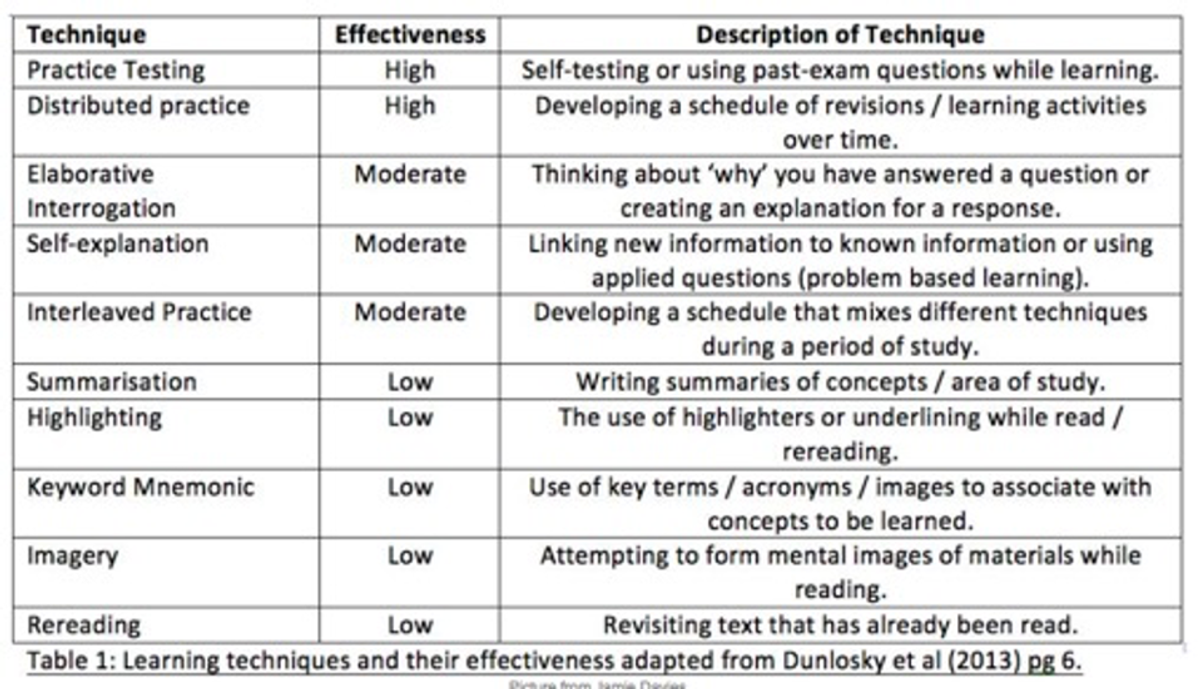Senior School - Study Tips
Years 9-12

Senior School - Study Tips
Years 9-12
What does the research say about the most effective study techniques. Here we take a look at Distributed Practice and Retrieval Practice:
Distributed Practice - Spacing out learning over time
Rather than intensively cramming right before an assessment, a more effective strategy is to distribute your study and learning over multiple sessions. This is known as spaced practice or distributed practice. By “spacing” learning activities out over time, you will be able to learn more information and retain it longer. The research says this, so why wouldn't you do it!
Unlike cramming, spaced practice involves multiple learning sessions, but each session is shorter. Having multiple sessions allows you to have a clear focus on a subset of materials during each session.


Each session is an opportunity for you to go back and review information that you previously learned. By repeatedly revisiting course materials over multiple sessions, you will be able to encode that information more effectively into long-term memory, fill in any gaps in your knowledge, and be better equipped to use that information on the next assessment.
The benefit of distributing learning over time is commonly known as the spacing effect. This effect has been demonstrated in over 200 research studies. Generally speaking, multiple practice sessions over time results in better long-term memory than a single practice session of equivalent duration or an equivalent number of repetitions.
How do I use spaced practice?
Take control of your calendar! Having a study timetable enables you to embed distributed practice / spaced practice throughout your week schedule.
To sum up, when using distributed practice, you should:
· Plan a “spaced” learning schedule ahead of time – using the as a guide, create a schedule where you start preparing for the SAC / exam early (weeks / months ahead ideally), and continue doing so at regular intervals until the SAC or actual exam date (your learning should be distributed out over days / weeks).
· Spend time preparing for the course at regular, periodic intervals – follow through with your plans by completing multiple learning sessions at regular intervals. Unlike cramming, each session does not need to be very long and does not need to cover all course materials; you should divide up materials across the different sessions.
· Focus on both new and old materials – as you prepare for any assessment, be sure to learn not just new materials, but also go back and practice content that you have already learned. This helps reduce forgetting (your memories stay “fresh”). It can help to allocate a certain amount of time to new vs. old materials (for example, 75% time spent on new materials, 25% time spent on old materials).
To try this technique, review your material in spaced intervals using the Pomodoro technique similar to the schedule below:
Day 1: Learn the material in class
Day 2: Revisit and review
Day 3: Revisit and review
After one week: Revisit and review
After two weeks: Revisit and review
Retrieval Practice
This technique refers to what you should be doing to prepare for assessments (that is, test yourself via practice tests or other recall-based techniques). Learning scientists have determined that one method is especially effective at helping you retain information and successfully retrieve it later. That method is retrieval practice.
What you should be doing when studying for a course isn’t just “studying”. A large body of research has shown that simply studying materials over and over (for instance, looking over your notes repeatedly) is not the most effective way to learn.
DON'T simply restudy information.
One of the reasons why restudying, rereading, and reviewing are not the most effective learning strategies is because they do not involve the actual cognitive processes that SACs and exams require. Specifically, on most assessments you must retrieve information from memory. There are no notes, lecture slides, or textbooks to consult. As such, the more thoroughly you have absorbed course content – and the more able you are to successfully retrieve that information during an important assessment – the better you are likely to do.
DO practice recalling information from memory.
After you have finished reading through a set of lecture slides, your notes, or the textbook, put it aside. Without looking at those materials, try to remember what you have just learned, either mentally or by writing it down. In effect, you are giving yourself a practice test. Some information will readily come to mind, and some information might not. Some materials might be completely understood, and other materials might not. After you have recalled as much as you can remember, go back, and check the course materials. Determine if the information that you recalled was correct and examine those portions that you did not fully recall or did not fully understand. Then, repeat the process.


If you have completed those steps, then you have just used retrieval practice. Retrieval practice involves recalling to-be-remembered information from memory. Retrieval practice – by itself and especially when accompanied by a subsequent check of course materials – is one of the most effective learning methods discovered to date. In fact, over 200 studies from over a century of research have demonstrated benefits of retrieval practice on memory.


How do I use retrieval practice?
There are many ways to practice retrieving information. It can be as simple as the example discussed above – put your course materials aside and simply try to recall information mentally or on a sheet of paper. Other ways to use retrieval practice include:
Overall, by using retrieval practice, you are increasing the likelihood that you will successfully remember relevant information during your next high-stakes SAC and exam.


Tim Pearson, David Black
& Darren Hoogkamer
Senior School Leaders